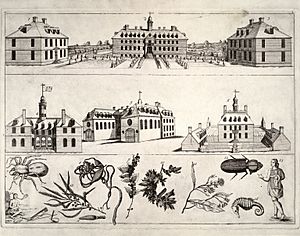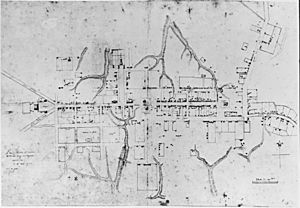History of Williamsburg, Virginia facts for kids

Williamsburg, Virginia, has a long and interesting history that goes back to the 1600s. It was first called Middle Plantation before changing its name to Williamsburg in 1699.
Contents
Early Days: The 1600s
Before English settlers arrived at Jamestown in 1607, the area where Williamsburg now stands was mostly forests. It was part of the land belonging to the Powhatan Confederacy, a group of Native American tribes. Early settlements were built near rivers because rivers were like highways back then. This made travel easy and helped protect settlers from conflicts with Native Americans.
By the 1630s, English settlements had grown across the eastern part of the Virginia Peninsula. Native American villages nearby were left empty as tribes moved to more distant places. However, they sometimes still attacked the colonists. To protect the farming and fishing communities, the colonists built a strong fence, called a stockade, across the peninsula.
The area that became Williamsburg was located in the middle of the Virginia Peninsula. It was a good distance from both the James River and the York River. Two creeks, College Creek and Queen's Creek, flowed into these rivers. By building the stockade between these two creeks, the land area was only about 6 kilometers (4 miles) wide, making it easier to defend.
Settlers arrived in the Williamsburg area in 1638. They called it Middle Plantation because it was on high ground, about halfway across the peninsula. The defensive fence, or palisade, built in 1634, was a key part of creating this settlement. Its exact path is not fully known, but archaeologists have found parts of it recently.
Jamestown was the first capital of the Virginia Colony. But it burned down during Bacon's Rebellion in 1676. After this, the government temporarily moved to Middle Plantation, about 12 kilometers (7.5 miles) away. The members of the House of Burgesses (Virginia's government assembly) found Middle Plantation safer and more pleasant than Jamestown, which was often hot and full of mosquitoes.
The colonists had always wanted a college. An early attempt at Henricus failed after a Native American attack in 1622. In the 1690s, they tried again. Reverend James Blair went to England and, after much effort, got a royal charter for a new school. It was named the College of William and Mary to honor the king and queen at the time. The college was founded in the safe location of Middle Plantation in 1693. Classes began in 1694, and the main college building, now called the Wren Building, was soon under construction.
Four years later, in 1698, the rebuilt statehouse in Jamestown accidentally burned down again. The government moved back to Middle Plantation temporarily. This time, they could use the college's buildings, and they still preferred the climate. After the fire, the college students asked the House of Burgesses to make Middle Plantation the permanent capital. In 1699, the colonial capital was officially moved there. A new town was planned, and Middle Plantation was renamed Williamsburg, honoring King William III of England. This new name fit the town's important new role.
Becoming a City: The 1700s
After Williamsburg became the capital, plans were quickly made to build a capitol building. The new city was also carefully laid out according to a survey by Theodorick Bland.
At first, the main street, which later became Duke of Gloucester Street, was just a simple horse path. It went through swampy areas and had houses blocking parts of it. In 1704, Governor Francis Nicholson asked the House of Burgesses to buy and tear down four old homes to clear the path. This was done, and the owner was paid. This event might be the first time in American history that private property was taken for public use, a process called condemnation.
Alexander Spotswood became Virginia's lieutenant governor in 1710. He helped fill in ravines and level the streets. He also helped build more college buildings, a church, and a magazine for storing weapons. In 1722, Williamsburg was given a royal charter as a city. It is now thought to be the oldest city charter in the United States.
Williamsburg was part of James City Shire when it was created in 1634. The border between James City County and York County ran down the middle of Duke of Gloucester Street for most of the colonial period. This meant parts of the town were in two different counties.
Williamsburg was also the site of the first canal planned in the United States. In 1771, Lord Dunmore, Virginia's Royal Governor, wanted to connect Archer's Creek (which leads to the James River) with Queen's Creek (which leads to the York River). This would have created a water shortcut across the Virginia Peninsula, but it was never finished. You can still see parts of this old canal behind the Governor's Palace in Colonial Williamsburg.
The first psychiatric hospital in the United States was built in Williamsburg in the 1770s. It was called the "Public Hospital for Persons of Insane and Disordered Minds." Today, it is known as Eastern State Hospital. The Virginia colonial government approved its creation in 1770. The hospital was built to care for people with mental health issues. It had a two-story building for 24 patients and yards where patients could walk.
In April 1775, a disagreement called the Gunpowder Incident happened in Williamsburg. Governor Dunmore ordered royal marines to take gunpowder from the Williamsburg Magazine. He was worried about another rebellion. Virginia militia, led by Patrick Henry, marched on Williamsburg to protest this "theft." There was a tense standoff, with Dunmore threatening to destroy the city. The problem was solved when payment for the gunpowder was arranged. This event was an important step leading up to the American Revolution.
After the Declaration of Independence in 1776, the American Revolutionary War began. In 1780, Virginia's capital was moved again, this time to Richmond. Governor Thomas Jefferson suggested this because he feared Williamsburg was too easy for the British to attack. However, many important meetings were still held in Williamsburg during the war.
A Quiet Time: The 1800s
After the capital moved in 1780, Williamsburg became less important. Unlike Jamestown, it didn't completely disappear. In the 18th and early 19th centuries, most travel was by rivers and canals. Williamsburg, built on "high ground," was not on a major waterway. Early railroads, starting in the 1830s, also didn't come through the town at first.
The main activities in Williamsburg became the college and the Public Hospital for Persons of Insane and Disordered Minds. Both the College of William and Mary and the hospital grew over time. The hospital is now known as Eastern State Hospital.
The American Civil War
When the American Civil War (1861–1865) began, many students from the College of William and Mary joined the Confederate Army. So, on May 10, 1861, the college closed. The College Building was used as a barracks for Confederate soldiers and later as a hospital for both Confederate and Union forces.
The Williamsburg area saw fighting in the spring of 1862 during the Peninsula Campaign. This was an effort by Union forces to capture Richmond, the Confederate capital. Confederate General John B. Magruder used clever tricks to make his small army seem much larger. This slowed down the Union advance, giving the Confederates valuable time to build defenses around Richmond.
In early May 1862, the Confederate defenders pulled back from their defensive line. As Union General George McClellan's forces moved forward, a Confederate rear guard, led by General James Longstreet and supported by General J.E.B. Stuart's cavalry, stopped them at the Williamsburg Line. This was a series of 14 small forts, with Fort Magruder (also called Redoubt #6) at a key crossroads. The college's president, Benjamin S. Ewell, who was also a Confederate officer, had helped design and build these defenses.
At the Battle of Williamsburg on May 5, 1862, the Confederates successfully delayed the Union forces. This allowed the main Confederate army to reach Richmond's defenses safely. The Union campaign to take Richmond failed, and the war continued for almost three more years.
On May 6, 1862, the Union army took control of Williamsburg. The Brafferton building at the college was used as a home for the Union commanding officer. On September 9, 1862, Union soldiers set fire to the College Building, supposedly to stop Confederate snipers from using it. The town suffered a lot of damage during the Union occupation, which lasted until September 1865.
After the Civil War
About 20 years later, in 1881, Collis P. Huntington's Chesapeake and Ohio Railway (C&O) built tracks through the area. This helped people travel and farmers ship their goods. The railroad was mainly built to carry coal to Newport News for export. The tracks were later moved from Duke of Gloucester Street.
The College of William and Mary continued its work. However, it temporarily closed from 1882 to 1886 due to money problems. It reopened when it became a state-supported school.
In the 1890s, a C&O land agent named Carl M. Bergh realized that the mild climate of eastern Virginia and low land prices after the Civil War would attract people from Scandinavia who were farming in colder northern states. He encouraged many Norwegian, Swedish, and Danish Americans to move to the area. A place west of Williamsburg, once called Vaiden's Siding, was renamed Norge (which means Norway in Norwegian). These new residents brought fresh energy to the old colonial capital area.
Bringing History to Life: The 1900s and 2000s
In the early 1900s, Williamsburg was a quiet town. Some new buildings were mixed with old colonial ones. Many locals were happy with how peaceful it was. One newspaper even jokingly called it "Lotusburg" because things moved so slowly there.
However, an Episcopalian priest named Reverend Dr. W.A.R. Goodwin had a big dream. He wanted to save and restore Williamsburg's historic buildings. He first worked to save his own church, Bruton Parish Church, by 1907. Later, he realized many other colonial buildings were also in bad shape.
Dr. Goodwin dreamed of a much larger restoration. He looked for support and funding from many people. Eventually, he got the interest and major financial help of Standard Oil heir and generous giver John D. Rockefeller Jr. and his wife Abby Aldrich Rockefeller. Together, they created Colonial Williamsburg. This project restored much of downtown Williamsburg, creating a 301-acre (1.2 km²) Historic Area. Its goal was to celebrate the patriots and the early history of America.
In the 21st century, Colonial Williamsburg continues to improve its attractions. It now has more features designed to interest modern children. It also offers better ways to learn about the experiences of African Americans in the colonial town. The work to maintain and improve this important part of Virginia and United States history is still ongoing.
Besides the Historic Area, Williamsburg's railroad station was restored. It now serves as a modern transportation hub. Near Williamsburg, an old C&O Railway station from 1908 in Norge was saved. It was moved in 2006 to the Williamsburg Regional Library property.
Today, Colonial Williamsburg is one of Virginia's most popular tourist attractions. It is the main part of the Historic Triangle, which also includes Jamestown and Yorktown. These three historic places are connected by the Colonial Parkway.
|




